Dell R330 User Manual

Dell PowerEdge R330
Owner's Manual
Regulatory Model: E34S Series
Regulatory Type: E34S001

Notes, cautions, and warnings
NOTE: A NOTE indicates important information that helps you make better use of your computer.
CAUTION: A CAUTION indicates either potential damage to hardware or loss of data and tells you how to avoid the problem.
WARNING: A WARNING indicates a potential for property damage, personal injury, or death.
Copyright © 2015 Dell Inc. All rights reserved. This product is protected by U.S. and international copyright and intellectual property laws. Dell™ and the Dell logo are trademarks of Dell Inc. in the United States and/or other jurisdictions. All other marks and names mentioned herein may be trademarks of their respective companies.
2015 - 09
Rev. A00
Contents |
|
1 About your system................................................................................................ |
9 |
Supported configurations on PowerEdge R330 systems.................................................................... |
9 |
Front panel features and indicators...................................................................................................... |
9 |
LCD panel features.............................................................................................................................. |
14 |
Diagnostic indicators........................................................................................................................... |
14 |
Hot swappable hard drive indicator codes......................................................................................... |
16 |
Back panel features and indicators..................................................................................................... |
17 |
NIC indicator codes............................................................................................................................. |
18 |
Indicator codes for redundant power supply unit............................................................................. |
19 |
Documentation matrix........................................................................................................................ |
20 |
Accessing system information by using QRL..................................................................................... |
21 |
2 Performing initial system configuration ....................................................... |
23 |
Setting up your system....................................................................................................................... |
23 |
Setting up and configuring the iDRAC IP address ............................................................................ |
23 |
Logging in to iDRAC............................................................................................................................ |
24 |
Methods of installing the operating system....................................................................................... |
24 |
Managing your system remotely........................................................................................................ |
24 |
Downloading drivers and firmware.................................................................................................... |
24 |
3 Pre-operating system management applications........................................ |
26 |
Navigation keys................................................................................................................................... |
26 |
About System Setup............................................................................................................................ |
27 |
Entering System Setup.................................................................................................................. |
27 |
System Setup Main Menu.............................................................................................................. |
27 |
System BIOS screen details........................................................................................................... |
27 |
System Information screen details............................................................................................... |
28 |
Memory Settings screen details.................................................................................................... |
29 |
Processor Settings screen details................................................................................................. |
29 |
SATA Settings screen details......................................................................................................... |
30 |
Boot Settings screen details.......................................................................................................... |
32 |
Network Settings screen details................................................................................................... |
33 |
Integrated Devices screen details................................................................................................. |
33 |
Serial Communication screen details........................................................................................... |
34 |
System Profile Settings screen details.......................................................................................... |
35 |
System Security Settings screen details....................................................................................... |
36 |
Miscellaneous Settings screen details.......................................................................................... |
38 |
About Boot Manager........................................................................................................................... |
39 |
3
Entering Boot Manager................................................................................................................. |
39 |
Boot Manager main menu............................................................................................................ |
39 |
About Dell Lifecycle Controller.......................................................................................................... |
39 |
Changing the boot order.................................................................................................................... |
39 |
Choosing the system boot mode...................................................................................................... |
40 |
Creating a system and setup password............................................................................................. |
40 |
Using your system password to secure your system......................................................................... |
41 |
Deleting or changing system password and setup password........................................................... |
41 |
Operating with a setup password enabled........................................................................................ |
42 |
Embedded system management....................................................................................................... |
42 |
iDRAC Settings utility.......................................................................................................................... |
42 |
Entering the iDRAC settings utility................................................................................................ |
42 |
Changing the thermal settings..................................................................................................... |
43 |
4 Installing and removing system components............................................... |
44 |
Safety instructions............................................................................................................................... |
44 |
Before working inside your system.................................................................................................... |
44 |
After working inside your system....................................................................................................... |
44 |
Recommended tools.......................................................................................................................... |
45 |
Front bezel (optional).......................................................................................................................... |
45 |
Installing the optional front bezel................................................................................................. |
45 |
Removing the optional front bezel.............................................................................................. |
46 |
System cover....................................................................................................................................... |
46 |
Removing the system cover......................................................................................................... |
46 |
Installing the system cover........................................................................................................... |
47 |
Inside the system................................................................................................................................ |
48 |
Intrusion switch................................................................................................................................... |
51 |
Removing the intrusion switch...................................................................................................... |
51 |
Installing the intrusion switch....................................................................................................... |
52 |
Cooling shroud.................................................................................................................................... |
52 |
Removing the cooling shroud...................................................................................................... |
52 |
Installing the cooling shroud........................................................................................................ |
53 |
System memory.................................................................................................................................. |
54 |
General memory module installation guidelines......................................................................... |
55 |
Sample memory configurations................................................................................................... |
55 |
Removing a memory module....................................................................................................... |
56 |
Installing a memory module......................................................................................................... |
57 |
Hard drives........................................................................................................................................... |
59 |
Supported hard drive configurations .......................................................................................... |
60 |
Removing a 2.5-inch hot swappable hard drive blank................................................................ |
60 |
Installing a 2.5-inch hot swappable hard drive blank.................................................................. |
61 |
Removing a 3.5-inch hot swappable hard drive carrier blank.................................................... |
62 |
4
Installing a 3.5-inch hot swappable hard drive carrier blank...................................................... |
62 |
Removing a 3.5-inch cabled hard drive carrier............................................................................ |
63 |
Removing a cabled hard drive from a hard drive carrier............................................................. |
64 |
Installing a cabled hard drive into a hard drive carrier................................................................. |
65 |
Installing a 3.5-inch cabled hard drive carrier............................................................................. |
66 |
Removing a hot swappable hard drive carrier............................................................................. |
67 |
Installing a hot swappable hard drive carrier............................................................................... |
68 |
Removing the optional 1.8-inch solid state drives...................................................................... |
69 |
Installing the optional 1.8-inch solid state drives......................................................................... |
70 |
Installing a 2.5-inch hot swappable hard drive into a 3.5-inch hard drive adapter.................... |
71 |
Removing a 2.5-inch hot swappable hard drive from a 3.5-inch hard drive adapter................ |
72 |
Installing a 3.5-inch hard drive adapter into the 3.5-inch hot swappable hard drive carrier..... |
73 |
Removing a 3.5-inch hard drive adapter from a 3.5-inch hot swappable hard drive carrier..... |
74 |
Removing a hot swappable hard drive from a hard drive carrier................................................ |
74 |
Installing a hot swappable hard drive into a hot swappable hard drive carrier.......................... |
75 |
Optical drive (optional)........................................................................................................................ |
76 |
Removing the optional optical drive............................................................................................ |
76 |
Installing the optional optical drive............................................................................................... |
77 |
Cooling fans........................................................................................................................................ |
78 |
Removing the cooling fan blank................................................................................................... |
78 |
Installing the cooling fan blank..................................................................................................... |
79 |
Removing a cooling fan................................................................................................................ |
80 |
Installing a cooling fan.................................................................................................................. |
81 |
Internal USB memory key (optional).................................................................................................. |
82 |
Replacing the optional internal USB memory key....................................................................... |
82 |
Expansion cards and expansion card riser......................................................................................... |
83 |
Expansion card installation guidelines......................................................................................... |
83 |
Removing the expansion card riser.............................................................................................. |
85 |
Installing the expansion card riser................................................................................................ |
86 |
Removing an expansion card........................................................................................................ |
87 |
Installing an expansion card......................................................................................................... |
88 |
Removing the internal PERC card................................................................................................ |
89 |
Installing the internal PERC card.................................................................................................. |
90 |
iDRAC port card (optional).................................................................................................................. |
91 |
Replacing an optional SD vFlash card........................................................................................... |
91 |
Removing the optional iDRAC port card...................................................................................... |
92 |
Installing the optional iDRAC port card........................................................................................ |
94 |
Internal dual SD module (optional).................................................................................................... |
94 |
Removing an optional internal SD card....................................................................................... |
94 |
Installing an optional internal SD card.......................................................................................... |
95 |
Removing the optional internal dual SD module......................................................................... |
95 |
Installing the optional internal dual SD module .......................................................................... |
97 |
5
Heat sink and processor..................................................................................................................... |
98 |
Removing the heat sink................................................................................................................ |
98 |
Removing the processor............................................................................................................... |
99 |
Installing the processor............................................................................................................... |
101 |
Installing the heat sink................................................................................................................. |
103 |
Power supply units............................................................................................................................ |
105 |
Hot spare feature......................................................................................................................... |
105 |
Removing a redundant power supply unit................................................................................. |
105 |
Installing a redundant power supply unit................................................................................... |
106 |
Removing the power supply unit blank...................................................................................... |
107 |
Installing the power supply unit blank....................................................................................... |
108 |
System battery................................................................................................................................... |
108 |
Replacing the system battery..................................................................................................... |
108 |
Hard drive backplane......................................................................................................................... |
110 |
Removing the hard drive backplane........................................................................................... |
110 |
Installing the hard drive backplane............................................................................................. |
119 |
Control panel assembly..................................................................................................................... |
119 |
Removing the LCD control panel assembly............................................................................... |
119 |
Installing the LCD control panel assembly................................................................................. |
121 |
Removing the LED control panel assembly............................................................................... |
122 |
Installing the LED control panel assembly................................................................................. |
123 |
Power interposer board.................................................................................................................... |
124 |
Removing the power interposer board...................................................................................... |
124 |
Installing the power interposer board........................................................................................ |
125 |
Trusted Platform Module.................................................................................................................. |
126 |
Installing the Trusted Platform Module...................................................................................... |
126 |
Re-enabling the TPM for BitLocker users................................................................................... |
127 |
Re-enabling the TPM for TXT users............................................................................................ |
127 |
System board..................................................................................................................................... |
128 |
Removing the system board....................................................................................................... |
128 |
Installing the system board......................................................................................................... |
130 |
5 Troubleshooting your system........................................................................ |
133 |
Safety first—for you and your system............................................................................................... |
133 |
Troubleshooting system startup failure............................................................................................ |
133 |
Troubleshooting external connections............................................................................................ |
133 |
Troubleshooting the video subsystem............................................................................................. |
133 |
Troubleshooting a USB device......................................................................................................... |
133 |
Troubleshooting iDRAC Direct (USB XML configuration)................................................................ |
134 |
Troubleshooting iDRAC Direct (Laptop connection)...................................................................... |
135 |
Troubleshooting a serial I/O device................................................................................................. |
135 |
Troubleshooting an NIC.................................................................................................................... |
135 |
6
Troubleshooting a wet system......................................................................................................... |
136 |
Troubleshooting a damaged system................................................................................................ |
137 |
Troubleshooting the system battery................................................................................................. |
137 |
Troubleshooting power supply units............................................................................................... |
138 |
Troubleshooting power source problems................................................................................. |
138 |
Power supply unit problems....................................................................................................... |
138 |
Troubleshooting cooling problems.................................................................................................. |
139 |
Troubleshooting cooling fans.......................................................................................................... |
139 |
Troubleshooting system memory.................................................................................................... |
140 |
Troubleshooting an internal USB key............................................................................................... |
141 |
Troubleshooting an SD card............................................................................................................. |
141 |
Troubleshooting an optical drive..................................................................................................... |
142 |
Troubleshooting a tape backup unit................................................................................................ |
143 |
Troubleshooting a hard drive........................................................................................................... |
143 |
Troubleshooting a storage controller.............................................................................................. |
144 |
Troubleshooting expansion cards.................................................................................................... |
145 |
Troubleshooting processors............................................................................................................. |
145 |
6 Using system diagnostics................................................................................ |
147 |
Dell Embedded System Diagnostics................................................................................................. |
147 |
When to use the Embedded System Diagnostics...................................................................... |
147 |
Running the Embedded System Diagnostics from Boot Manager............................................ |
147 |
Running the Embedded System Diagnostics from the Dell Lifecycle Controller..................... |
147 |
System diagnostics controls....................................................................................................... |
148 |
7 Jumpers and connectors................................................................................ |
149 |
System board jumper settings.......................................................................................................... |
149 |
System board connectors................................................................................................................. |
150 |
Disabling a forgotten password........................................................................................................ |
151 |
8 Technical specifications.................................................................................. |
153 |
Dimensions and weight..................................................................................................................... |
153 |
Processor specifications................................................................................................................... |
153 |
Expansion bus specifications............................................................................................................ |
154 |
Memory specifications...................................................................................................................... |
154 |
Power specifications......................................................................................................................... |
154 |
Storage controller specifications...................................................................................................... |
155 |
Drive specifications........................................................................................................................... |
155 |
Connectors specifications................................................................................................................ |
156 |
Video specifications.......................................................................................................................... |
156 |
Expanded operating temperature.................................................................................................... |
156 |
Environmental specifications............................................................................................................ |
157 |
7
9 Getting help....................................................................................................... |
160 |
Contacting Dell................................................................................................................................. |
160 |
Locating your system Service Tag.................................................................................................... |
160 |
Documentation feedback................................................................................................................. |
160 |
8
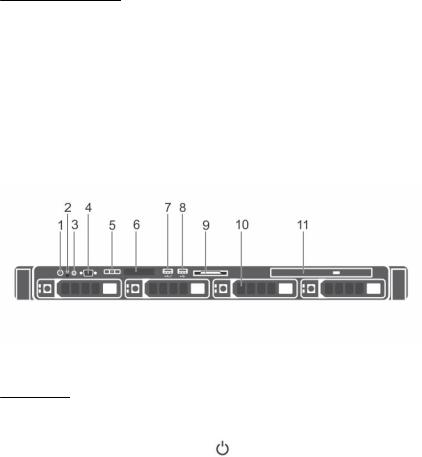
1
About your system
The Dell PowerEdge R330 rack server supports one processor based on the Intel E3-1200V5 series, up to 4 DIMMs, and up to eight hard drives or solid state drives (SSDs).
Supported configurations on PowerEdge R330 systems
The PowerEdge R330 systems are available in the following configurations:
Table 1. Supported configurations on PowerEdge R330 systems
System |
Configuration |
|
|
Four hard drive |
Up to four 3.5-inch, cabled hard drives and two optional 1.8-inch solid state |
systems |
drives (SSDs) in the optical drive slot |
|
Up to four 3.5-inch (2.5-inch with adapter), hot-swappable hard drives |
Eight hard drive |
Up to eight 2.5-inch, hot-swappable hard drives or SSDs |
systems |
|
Front panel features and indicators
Figure 1. Front panel features and indicators — four 3.5-inch hot-swappable hard drive chassis
Table 2. Front panel features and indicators— four 3.5-inch hot-swappable hard drive chassis
Item |
Indicator, button, or |
Icon |
Description |
|
connector |
|
|
|
|
|
|
1 |
Power-on indicator, |
|
Enables you to know the power status of the system. |
|
power button |
|
The power-on indicator glows when the system |
|
|
|
power is on. The power button controls the power |
|
|
|
supply output to the system. |
9

Item |
Indicator, button, or |
Icon |
Description |
|
connector |
|
|
|
|
|
|
|
|
|
NOTE: On ACPI-compliant operating systems, |
|
|
|
turning off the system by pressing the power |
|
|
|
button causes the system to perform a graceful |
|
|
|
shutdown before power to the system is turned |
|
|
|
off. |
2 |
NMI button |
|
Enables you to troubleshoot software and device |
|
|
|
driver errors when running certain operating |
|
|
|
systems. This button can be pressed by using the |
|
|
|
end of a paper clip. |
|
|
|
Use this button only if directed to do so by qualified |
|
|
|
support personnel or by the operating system's |
|
|
|
documentation. |
3 |
System identification |
|
Enables you to locate a particular system within a |
|
button |
|
rack. The identification buttons are on the front and |
|
|
|
back panels. When one of these buttons is pressed, |
|
|
|
the LCD panel on the front and the system status |
|
|
|
indicator on the back flash until one of the buttons is |
|
|
|
pressed again. |
|
|
|
Press the system identification button to turn the |
|
|
|
system ID on or off. |
|
|
|
If the system stops responding during POST, press |
|
|
|
and hold the system ID button for more than five |
|
|
|
seconds to enter BIOS progress mode. |
|
|
|
To reset iDRAC (if not disabled in F2 iDRAC setup), |
|
|
|
press and hold the button for more than 15 seconds. |
4 |
Video connector |
|
Enables you to connect a display to the system. |
5 |
LCD menu buttons |
|
Enable you to navigate the control panel LCD menu. |
6 |
LCD panel |
|
Displays system ID, status information, and system |
|
|
|
error messages. See LCD panel features. |
|
|
|
NOTE: LCD panel is not available in a cabled |
|
|
|
hard drive chassis. |
7 |
USB management port/ |
|
Functions as a regular USB port or provide access to |
|
iDRAC managed USB |
|
the iDRAC Direct features. For more information, see |
|
port |
|
the iDRAC User’s Guide at Dell.com/idracmanuals. |
8 |
USB connector |
|
Enables you to connect USB devices to the system. |
|
|
|
The port is USB 2.0-compliant. |
9 |
Information tag |
|
Contains system information such as service tag, |
|
|
|
NIC, MAC address for your reference. The |
|
|
|
information tag is a slide-out label panel. |
10
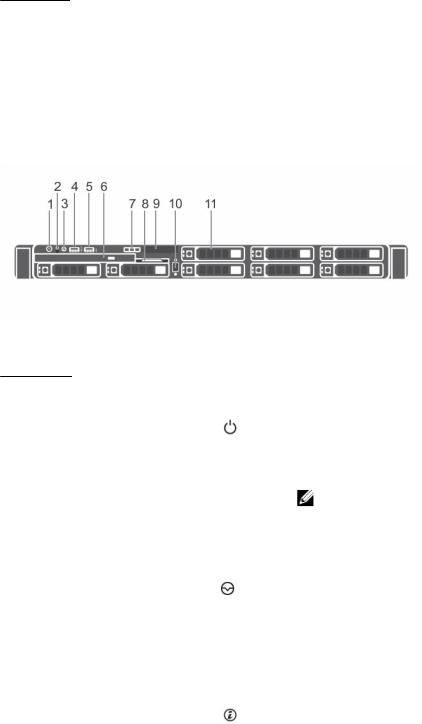
Item |
Indicator, button, or |
Icon |
Description |
|
connector |
|
|
|
|
|
|
10 |
Hard drives slots |
|
Enables you to install up to four 3.5-inch hot- |
|
|
|
swappable hard drives or four 2.5-inch hot- |
|
|
|
swappable hard drives in 3.5-inch hard drive |
|
|
|
adapters. |
11 |
Optical drive slot |
|
Enables you to install an optional slim SATA DVD- |
|
|
|
ROM drive or DVD+/-RW drive. |
Figure 2. Front panel features and indicators — eight 2.5-inch hot-swappable hard drives or SSDs chassis
Table 3. Front panel features and indicators—eight 2.5-inch hot-swappable hard drives or SSDs chassis
Item |
Indicator, Button, or |
Icon |
Description |
|
Connector |
|
|
|
|
|
|
1 |
Power-on indicator, |
|
Enables you to know the power status of the |
|
power button |
|
system. The power-on indicator glows when the |
|
|
|
system power is on. The power button controls |
|
|
|
the power supply output to the system. |
|
|
|
NOTE: On ACPI-compliant operating |
|
|
|
systems, turning off the system by pressing |
|
|
|
the power button causes the system to |
|
|
|
perform a graceful shutdown before power |
|
|
|
to the system is turned off. |
2 |
NMI button |
|
Enables you to troubleshoot software and device |
|
|
|
driver errors when running certain operating |
|
|
|
systems. This button can be pressed by using the |
|
|
|
end of a paper clip. |
|
|
|
Use this button only if directed to do so by |
|
|
|
qualified support personnel or by the operating |
|
|
|
system's documentation. |
3 |
System identification |
|
Enables you to locate a particular system within a |
|
button |
|
rack. The identification buttons are on the front |
|
|
|
and back panels. When one of these buttons is |
|
|
|
pressed, the LCD panel on the front and the |
|
|
|
system status indicator on the back flash until one |
|
|
|
of the buttons is pressed again. |
11
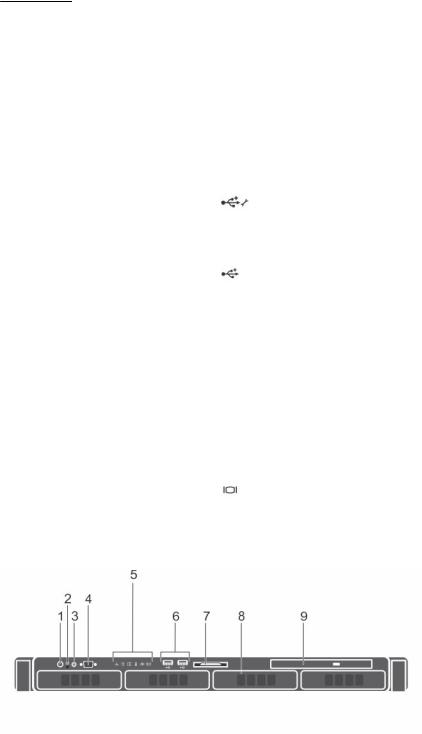
Item |
Indicator, Button, or |
Icon |
Description |
|
Connector |
|
|
|
|
|
|
|
|
|
Press the system identification button to turn the |
|
|
|
system ID on or off. |
|
|
|
If the system stops responding during POST, press |
|
|
|
and hold the system ID button for more than five |
|
|
|
seconds to enter BIOS progress mode. |
|
|
|
To reset iDRAC (if not disabled in F2 iDRAC setup), |
|
|
|
press and hold the button for more than 15 |
|
|
|
seconds. |
4 |
USB management port/ |
|
Functions as a regular USB port or provide access |
|
iDRAC managed USB |
|
to the iDRAC Direct features. For more |
|
port |
|
information, see the iDRAC User’s Guide at |
|
|
|
Dell.com/idracmanuals. |
5 |
USB connector |
|
Enables you to connect USB devices to the |
|
|
|
system. The port is USB 2.0-compliant. |
6 |
Optical drive slot |
|
Enables you to install an optional slim SATA DVD- |
|
|
|
ROM drive or DVD+/-RW drive. |
7 |
LCD menu buttons |
|
Enable you to navigate the control panel LCD |
|
|
|
menu. |
8 |
Information tag |
|
Contains system information such as service tag, |
|
|
|
NIC, MAC address for your reference. The |
|
|
|
information tag is a slide-out label panel. |
9 |
LCD panel |
|
Displays system ID, status information, and system |
|
|
|
error messages. See LCD panel features. |
10 |
Video connector |
|
Enables you to connect a VGA display to the |
|
|
|
system. |
11 |
Hard drive slots |
|
Enables you to install up to eight 2.5-inch hot |
|
|
|
swappable hard drives. |
Figure 3. Front panel features and indicators — four 3.5-inch cabled hard drive chassis
12

Table 4. Front panel features and indicators — four 3.5-inch cabled hard drive chassis
Item |
Indicator, Button, or |
Icon |
Description |
|
Connector |
|
|
|
|
|
|
1 |
Power-on indicator, |
|
Enables you to know the power status of the |
|
power button |
|
system. The power-on indicator glows when the |
|
|
|
system power is on. The power button controls |
|
|
|
the power supply output to the system. |
|
|
|
NOTE: On ACPI-compliant operating systems, |
|
|
|
turning off the system by pressing the power |
|
|
|
button causes the system to perform a |
|
|
|
graceful shutdown before power to the |
|
|
|
system is turned off. |
2 |
NMI button |
|
Enables you to troubleshoot software and device |
|
|
|
driver errors when running certain operating |
|
|
|
systems. This button can be pressed by using the |
|
|
|
end of a paper clip. |
|
|
|
Use this button only if directed to do so by |
|
|
|
qualified support personnel or by the operating |
|
|
|
system's documentation. |
3 |
System identification |
|
Enables you to locate a particular system within a |
|
button |
|
rack. The identification buttons are on the front |
|
|
|
and back panels. When one of these buttons is |
|
|
|
pressed, the LCD panel on the front and the |
|
|
|
system status indicator on the back flash until one |
|
|
|
of the buttons is pressed again. |
|
|
|
Press the system identification button to turn the |
|
|
|
system ID on or off. |
|
|
|
If the system stops responding during POST, press |
|
|
|
and hold the system ID button for more than five |
|
|
|
seconds to enter BIOS progress mode. |
|
|
|
To reset iDRAC (if not disabled in F2 iDRAC setup), |
|
|
|
press and hold the button for more than 15 |
|
|
|
seconds. |
4 |
Video connector |
|
Enables you to connect a display to the system. |
5 |
Diagnostic indicators |
|
Glows to display error status. For more |
|
|
|
information, see Diagnostic indicators. |
6 |
USB connectors |
|
Enable you to connect USB devices to the system. |
|
|
|
The ports are USB 2.0-compliant. |
7 |
Information tag |
|
Contains system information such as service tag, |
|
|
|
NIC, MAC address for your reference. The |
|
|
|
information tag is a slide-out label panel. |
8 |
Hard drive slots |
|
Enables you to install up to four 3.5-inch cabled |
|
|
|
hard drives. |
13

Item |
Indicator, Button, or |
Icon |
Description |
|
Connector |
|
|
|
|
|
|
9 |
Optical drive or solid |
|
Enables you to install one optional SATA DVD- |
|
state drive (SSDs) slot |
|
ROM drive or DVD+/-RW drive, or two optional |
|
|
|
1.8-inch SSDs |
LCD panel features
The system's LCD panel provides system information and status and error messages to indicate if the system is operating correctly or if the system needs attention. For more information about the error messages, see the Dell Event and Error Messages Reference Guide at Dell.com/openmanagemanuals >
OpenManage software.
•The LCD backlight turns blue during normal operating conditions and turns amber to indicate an error condition.
•The LCD backlight is turned off when the system is in standby mode and can be turned on by pressing either the Select, Left, or Right button on the LCD panel.
•The LCD backlight remains OFF if LCD messaging is turned off through the iDRAC utility, the LCD panel, or other tools.
Figure 4. LCD panel Features
1. |
Left |
2. |
Select |
3.Right
Button |
Description |
Left |
Moves the cursor back in one-step increments. |
Select |
Selects the menu item highlighted by the cursor. |
Right |
Moves the cursor forward in one-step increments. |
|
During message scrolling: |
|
• Press once to increase scrolling speed |
|
• Press again to stop |
|
• Press again to return to the default scrolling speed |
|
• Press again to repeat the cycle |
Diagnostic indicators
The diagnostic indicators on the system front panel display error status during system startup.
14

NOTE: No diagnostic indicators are lit when the system is switched off. To start the system, plug it into a working power source and press the power button.
Table 5. Diagnostic indicators
Icon |
Description |
Condition |
Corrective action |
|
|
|
|
|
Health |
If the system is on and in |
None required. |
|
indicator |
good health, the indicator |
|
|
|
turns solid blue. |
|
The indicator flashes amber if the system is on or in standby, and if any error exists (for example, a failed fan or hard drive).
Hard drive |
The indicator flashes amber |
indicator |
if there is a hard drive error. |
Check the System Event Log or system messages for the specific issue. For more information about error messages, see the Dell Event and Error Messages Reference Guide at Dell.com/openmanagemanuals > OpenManage software.
Invalid memory configurations can cause the system to halt at startup without any video output. See Getting help.
Check the System Event Log to determine the hard drive that has an error. Run the appropriate Online Diagnostics test. Restart the system and run embedded diagnostics (ePSA). If the hard drives are configured in a RAID array, restart the system and enter the host adapter configuration utility program.
Electrical |
The indicator flashes amber |
indicator |
if the system experiences an |
|
electrical error (for example, |
|
voltage out of range, or a |
|
failed power supply unit |
|
(PSU) or voltage regulator). |
Check the System Event Log or system messages for the specific issue. If it is due to a problem with the PSU, check the LED on the PSU. Reseat the PSU. If the problem persists, see Getting help.
Temperature |
The indicator flashes amber |
indicator |
if the system experiences a |
|
thermal error (for example, a |
|
temperature out of range or |
|
fan failure). |
Memory |
The indicator flashes amber |
indicator |
if a memory error occurs. |
Ensure that none of the following conditions exist:
•A cooling fan is removed or has failed.
•System cover, cooling shroud, EMI filler panel, memory module blank, or back filler bracket is removed.
•Ambient temperature is too high.
•External airflow is obstructed.
See Getting help.
Check the system event log or system messages for the location of the failed memory. Reseat the memory module. If the problem persists, see Getting help.
15
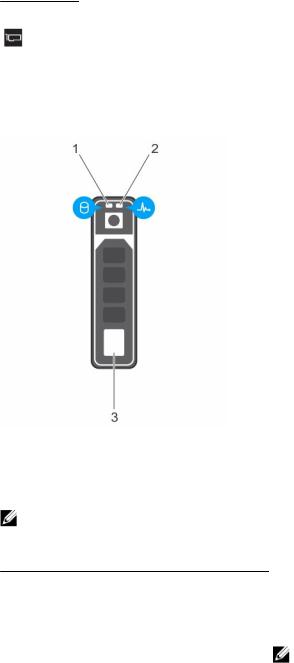
Icon |
Description |
Condition |
Corrective action |
|
|
|
|
|
PCIe indicator |
The indicator flashes amber |
Restart the system. Update any required |
|
|
if a PCIe card experiences |
drivers for the PCIe card. Reinstall the card. |
|
|
an error. |
If the problem persists, see Getting help. |
Hot swappable hard drive indicator codes
Figure 5. Hot swappable hard drive indicators
1. |
hard drive activity indicator |
2. |
hard drive status indicator |
3.hard drive
NOTE: If the hard drive is in Advanced Host Controller Interface (AHCI) mode, the status indicator (on the right side) does not function and remains OFF.
Table 6. Hot swappable hard drive indicators
Drive-status indicator pattern (RAID only) |
Condition |
|
|
Flashes green two times per second |
Identifying drive or preparing for removal. |
OFF |
Drive ready for insertion or removal. |
|
NOTE: The drive status indicator remains OFF |
|
until all hard drives are initialized after the system |
|
is turned on. Drives are not ready for insertion or |
|
removal during this time. |
Flashes green, amber, and turns off |
Predicted drive failure |
Flashes amber four times per second |
Drive failed |
Flashes green slowly |
Drive rebuilding |
Turns green |
Drive online |
16
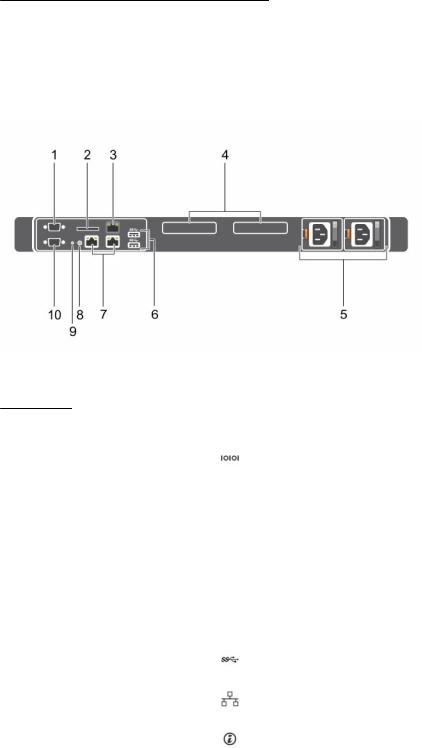
Drive-status indicator pattern (RAID only) |
Condition |
|
|
Flashes green three seconds, amber three |
Rebuild stopped |
seconds, and turns off six seconds |
|
Back panel features and indicators
Figure 6. Back panel features and indicators
Table 7. Back panel features and indicators
Item |
Indicator, button, or |
Icon |
Description |
|
connector |
|
|
|
|
|
|
1 |
Serial connector |
|
Enables you to connect a serial device to the |
|
|
|
system. |
2 |
vFlash card slot |
|
Enables you to connect the vFlash card. |
|
(optional) |
|
|
3 |
iDRAC port (optional) |
|
Enables you to install a dedicated management |
|
|
|
port card. |
4 |
PCIe expansion card |
|
Enable you to connect PCI Express expansion |
|
slots (2) |
|
cards. |
5 |
Power supply unit (PSU1 |
|
Enables you to install up to two 350 W redundant |
|
and PSU2) |
|
AC power supply units. |
6 |
USB connectors |
|
Enable you to connect USB devices to the system. |
|
|
|
These ports are USB 3.0-compliant. |
7 |
Ethernet connectors |
|
Enable you to connect Integrated 10/100/1000 |
|
|
|
Mbps NIC connectors. |
8 |
System identification |
|
Enables you to locate a particular system within a |
|
button |
|
rack. The identification buttons are on the front |
|
|
|
and back panels. When one of these buttons is |
|
|
|
pressed, the LCD panel on the front and the |
17
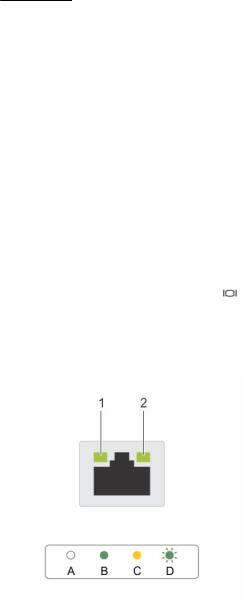
Item |
Indicator, button, or |
Icon |
Description |
|
connector |
|
|
|
|
|
|
|
|
|
system status indicator on the back flash until one |
|
|
|
of the buttons is pressed again. |
|
|
|
Press the system identification button to turn the |
|
|
|
system ID on or off. |
|
|
|
If the system stops responding during POST, press |
|
|
|
and hold the system ID button for more than five |
|
|
|
seconds to enter BIOS progress mode. |
|
|
|
To reset iDRAC (if not disabled in F2 iDRAC setup), |
|
|
|
press and hold the button for more than 15 |
|
|
|
seconds. |
9 |
System identification |
|
Connects the optional system status indicator |
|
connector |
|
assembly through the optional cable management |
|
|
|
arm. |
10 |
Video connector |
|
Enables you to connect a VGA display to the |
|
|
|
system. |
NIC indicator codes
Figure 7. NIC indicators |
|
|
||
1. |
link indicator |
2. |
activity indicator |
|
Table 8. NIC indicators |
|
|
||
|
|
|
|
|
Convention |
Indicator pattern |
Description |
|
|
|
|
|
|
|
A |
|
Link and activity indicators |
The NIC is not connected to the network. |
|
|
|
are OFF |
|
|
B |
|
Link indicator is green |
The NIC is connected to a valid network at its maximum |
|
|
|
|
port speed (1 Gbps). |
|
18
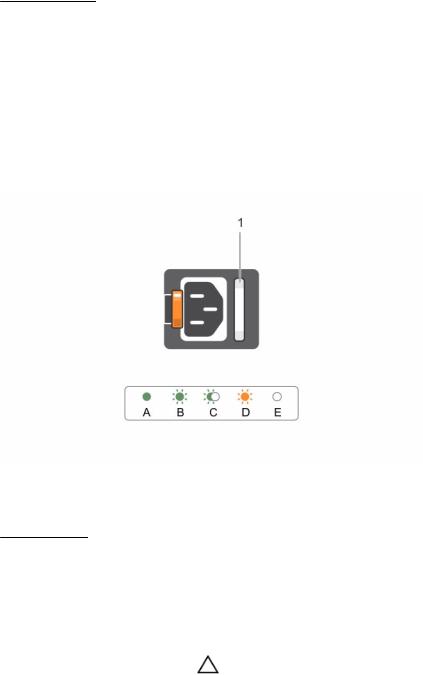
Convention |
Indicator pattern |
Description |
|
|
|
C |
Link indicator is yellow |
The NIC is connected to a valid network at less than its |
|
|
maximum port speed. |
D |
Activity indicator is flashing |
Network data is being sent or received. |
|
green |
|
Indicator codes for redundant power supply unit
Each AC power supply unit (PSU) has an illuminated translucent handle that indicates whether power is present or whether a power fault has occurred.
Figure 8. AC PSU status indicator
1. AC PSU status indicator or handle
Table 9. Redundant AC PSU status indicator
Convention |
Power Indicator |
Condition |
|
Pattern |
|
|
|
|
A |
Green |
A valid power source is connected to the PSU and the PSU is |
|
|
operational. |
B |
Flashing green |
When the PSU firmware is being updated, the PSU handle flashes |
|
|
green. |
|
|
CAUTION: Do not disconnect the power cord or unplug the |
|
|
PSU when updating firmware. If firmware update is |
|
|
interrupted, the PSUs will not function. You must roll back the |
|
|
PSU firmware by using Dell Lifecycle Controller. For more |
|
|
information, see Dell Lifecycle Controller User’s Guide at |
|
|
Dell.com/idracmanuals. |
C |
Flashing green |
When hot-adding a PSU, the PSU handle flashes green five times at |
|
and turns off |
4 Hz rate and turns off. This indicates that there is a PSU mismatch |
19

Convention |
Power Indicator |
Condition |
|
Pattern |
|
|
|
|
|
|
with respect to efficiency, feature set, health status, and supported |
|
|
voltage. Ensure that both the PSUs are the same. |
D |
Flashing amber |
Indicates a problem with the PSU. |
|
|
CAUTION: When correcting a PSU mismatch, replace only the |
|
|
PSU with the flashing indicator. Swapping the other PSU to |
|
|
make a matched pair can result in an error condition and |
|
|
unexpected system shutdown. To change from a High Output |
|
|
configuration to a Low Output configuration or vice versa, |
|
|
you must turn off the system. |
|
|
CAUTION: AC PSUs support both 220 V and 110 V input |
|
|
voltages with the exception of Titanium PSUs, which support |
|
|
only 220 V. When two identical PSUs receive different input |
|
|
voltages, they can output different wattages, and trigger a |
|
|
mismatch. |
|
|
CAUTION: If two PSUs are used, they must be of the same type |
|
|
and have the same maximum output power. |
|
|
CAUTION: Combining AC and DC PSUs is not supported and |
|
|
triggers a mismatch. |
E |
Not lit |
Power is not connected. |
Documentation matrix
The documentation matrix provides information on documents that you can refer to for setting up and managing your system.
Table 10. Documentation matrix
To... |
See the... |
|
|
Install your system into a rack |
Rack documentation included with your rack |
|
solution |
Set up your system and know the system technical specifications
Install the operating system
Getting Started With Your System that shipped with your system or see Dell.com/poweredgemanuals
Operating system documentation at Dell.com/ operatingsystemmanuals
Get an overview of the Dell Systems Management offerings
Dell OpenManage Systems Management Overview Guide at Dell.com/openmanagemanuals > OpenManage software
Configure and log in to iDRAC, set up managed |
Integrated Dell Remote Access Controller User's |
and management system, know the iDRAC |
Guide at Dell.com/idracmanuals |
features, and troubleshoot by using iDRAC |
|
Know about the RACADM subcommands and supported RACADM interfaces
RACADM Command Line Reference Guide for iDRAC at Dell.com/idracmanuals
20

To... |
See the... |
|
|
Launch, enable, and disable Dell Lifecycle |
Dell Lifecycle Controller User’s Guide at Dell.com/ |
Controller, know the features, use and |
idracmanuals |
troubleshoot Dell Lifecycle Controller |
|
Use Dell Lifecycle Controller Remote Services |
Dell Lifecycle Controller Remote Services Quick |
|
Start Guide at Dell.com/idracmanuals |
Set up, use, and troubleshoot OpenManage Server |
Dell OpenManage Server Administrator User’s |
Administrator |
Guide at Dell.com/openmanagemanuals > |
|
OpenManage Server Administrator |
Install, use, and troubleshoot OpenManage |
Dell OpenManage Essentials User’s Guide at |
Essentials |
Dell.com/openmanagemanuals > OpenManage |
|
Essentials |
Know the features of the storage controller cards, deploy the cards, and manage the storage subsystem
Storage controller documentation at Dell.com/ storagecontrollermanuals
Check the event and error messages generated by |
Dell Event and Error Messages Reference Guide at |
the system firmware and agents that monitor |
Dell.com/openmanagemanuals > OpenManage |
system components |
software |
Accessing system information by using QRL
You can use the Quick Resource Locator (QRL) to get immediate access to the information about your system.
Prerequisites
Ensure that your smartphone or tablet has the QR code scanner installed.
About this task
The QRL includes the following information about your system:
•How-to videos
•Reference materials, including the Owner’s Manual, LCD diagnostics, and mechanical overview
•Your system service tag to quickly access your specific hardware configuration and warranty information
•A direct link to Dell to contact technical support and sales teams
Steps
1.Go to Dell.com/QRL and navigate to your specific product or
2.Use your smartphone or tablet to scan the model-specific Quick Resource (QR) code located in the following image or on your Dell PowerEdge system:
21

22

2
Performing initial system configuration
After you receive your system, you must set up your system, install the operating system if it is not preinstalled, and set up and configure the system iDRAC IP address.
Setting up your system
1.Unpack the system.
2.Install the system into the rack. For more information about installing the system into the rack, see your system Rack Installation placemat at Dell.com/poweredgemanuals.
3.Connect the peripherals to the system.
4.Connect the system to its electrical outlet.
5.Turn the system on by pressing the power button or by using iDRAC.
6.Turn on the attached peripherals.
Setting up and configuring the iDRAC IP address
You can set up the Integrated Dell Remote Access Controller (iDRAC) IP address by using one of the following interfaces:
•iDRAC Settings utility
•Dell Lifecycle Controller
•Dell OpenManage Deployment Toolkit
•Server LCD panel
You can use the default iDRAC IP address 192.168.0.120 to configure the initial network settings, including setting up DHCP or a static IP for iDRAC.
NOTE: To access iDRAC, ensure that you install the iDRAC port card or connect the network cable to the Ethernet connector 1 on the system board.
You can configure iDRAC IP address by using the following interfaces:
NOTE: Make sure that you change the default user name and password after setting up the iDRAC IP address.
•iDRAC web interface — For more information, see the Integrated Dell Remote Access Controller User's Guide.
•Remote Access Controller Admin (RACADM) — For more information, see the RACADM Command Line Interface Reference Guide and the Integrated Dell Remote Access Controller User's Guide.
•Remote Services that include Web Services Management (WS-Man) — For more information, see the Dell Lifecycle Controller Remote Services Quick Start Guide.
23
For more information about setting up and configuring iDRAC, see the Integrated Dell Remote Access Controller User's Guide at Dell.com/idracmanuals.
Logging in to iDRAC
You can log in to iDRAC as an iDRAC local user, a Microsoft Active Directory user, or a Lightweight Directory Access Protocol (LDAP) user. You can also log in by using Single Sign-On or a Smart Card. The default user name is root and password is calvin. For more information about logging in to iDRAC and iDRAC licenses, see the Integrated Dell Remote Access Controller User's Guide at Dell.com/ idracmanuals.
You can also access iDRAC by using RACADM. For more information, see the RACADM Command Line Interface Reference Guide and the Integrated Dell Remote Access Controller User's Guide available at
Dell.com/idracmanuals.
Methods of installing the operating system
If the system is shipped without an operating system, install the supported operating system on the system by using one of the following methods:
•Dell Systems Management Tools and Documentation media — see the operating system documentation at Dell.com/operatingsystemmanuals.
•Dell Lifecycle Controller — see the Dell Lifecycle Controller documentation at Dell.com/ idracmanuals.
•Dell OpenManage Deployment Toolkit — see the Dell OpenManage documentation at Dell.com/ openmanagemanuals > OpenManage software.
For information on the list of operating systems supported on your system, see the operating system’s support matrix at Dell.com/ossupport.
Managing your system remotely
To perform out-of-band systems management using iDRAC, you must configure iDRAC for remote accessibility, set up the management station and managed system, and configure the supported Web browsers. For more information, see the Integrated Dell Remote Access Controller User’s Guide at
Dell.com/idracmanuals.
You can also remotely monitor and manage the server by using the Dell OpenManage Server Administrator (OMSA) software and OpenManage Essentials (OME) systems management console. For more information, see Dell.com/openmanagemanuals > OpenManage Server Administrator or Dell.com/openmanagemanuals > OpenManage Essentials.
Downloading drivers and firmware
It is recommended that you download and install the latest BIOS, drivers, and systems management firmware on your system.
Prerequisites
Ensure that you clear the web browser cache.
24

Steps
1.Go to Dell.com/support/drivers.
2.In the Product Selection section, enter the Service Tag of your system in the Service Tag or Express Service Code field.
NOTE: If you do not have the Service Tag, select Automatically detect my Service Tag for me to enable the system to automatically detect your service tag, or select your product from the
Product Selection page.
3.Click Get drivers and downloads.
The drivers that are applicable to your selection are displayed.
4.Download the drivers that you need to a USB drive, CD, or DVD.
25

3
Pre-operating system management applications
The pre-operating system management applications for your system help you manage different settings and features without booting to the operating system.
Your system has the following pre-operating system management applications:
•System Setup
•Boot Manager
•Dell Lifecycle Controller
•Preboot Execution Environment (PXE)
Navigation keys
The navigation keys can help you quickly access the pre-operating system management applications.
Key |
Description |
F2 |
Enables you to enter System Setup. |
F10 |
Enables you to enter system services and starts Lifecycle Controller. |
F11 |
Enables you to enter Boot Manager. |
F12 |
Enables you to enter PXE Boot. |
Page Up |
Enables you to move to the previous screen. |
Page Down |
Enables you to move to the next screen. |
Up arrow |
Enables you to move to the previous field. |
Down arrow |
Enables you to move to the next field. |
Enter |
Enables you to type a value in the selected field (if applicable). |
Spacebar |
Enables you to expand or collapse a drop-down list, if applicable. |
Tab |
Enables you to move to the next menu item. |
|
NOTE: This feature is applicable only for the standard graphic browser. |
Esc |
Enables you to move to the previous page until you view the main screen. Pressing |
|
Esc in the main screen exits System BIOS, iDRAC Settings, Device Settings, or |
|
Service Tag Settings, and proceeds with system boot. |
F1 |
Displays the system setup help. |
26

About System Setup
By using the System Setup screen, you can configure the BIOS settings, iDRAC settings, and device settings of your system.
NOTE: Help text for the selected field is displayed in the graphical browser by default. To view the help text in the text browser, press F1.
You can access system setup in two ways:
•Standard graphical browser — The browser is enabled by default.
•Text Browser — The browser is enabled by using Console Redirection.
Entering System Setup
1.Turn on, or restart your system.
2.Press F2 immediately after you see the following message:
F2 = System Setup
If your operating system begins to load before you press F2, wait for the system to finish booting, and then restart your system and try again.
System Setup Main Menu
The System Setup Main Menu screen details are explained as follows:
Option |
Description |
System BIOS |
Enables you to configure BIOS settings. |
iDRAC Settings |
Enables you to configure iDRAC settings. |
|
The iDRAC settings utility is an interface to set up and configure the iDRAC |
|
parameters by using UEFI. You can enable or disable various iDRAC parameters by |
|
using the iDRAC settings utility. For more information about this utility, see |
|
Integrated Dell Remote Access Controller User’s Guide at Dell.com/idracmanuals. |
Device Settings |
Enables you to configure device settings. |
System BIOS screen details
You can use the System BIOS screen to edit specific functions such as boot order, system password, setup password, set the RAID mode, and enable or disable USB ports.
To view the System BIOS screen, click System Setup Main Menu → System BIOS. The System BIOS screen details are explained as follows:
Option |
Description |
System |
Displays information about the system such as the system model name, BIOS |
Information |
version, and Service Tag. |
Memory Settings |
Displays information and options related to the installed memory. |
27
Option Description
Processor Settings Displays information and options related to the processor such as speed, cache size.
SATA Settings |
Displays options to enable or disable the integrated SATA controller and ports. |
Boot Settings |
Displays options to specify the boot mode (BIOS or UEFI). Enables you to modify |
|
UEFI and BIOS boot settings. |
Network Settings |
Displays options to change the network settings. |
Integrated |
Displays options to manage integrated device controllers and ports and specify |
Devices |
related features and options. |
Serial |
Displays options to manage the serial ports and specify related features and |
Communication |
options. |
System Profile |
Displays options to change the processor power management settings, memory |
Settings |
frequency, and so on. |
System Security |
Displays options to configure the system security settings, such as system |
|
password, setup password, Trusted Platform Module (TPM) security. It also |
|
manages the power and NMI buttons on the system. |
Miscellaneous |
Displays options to change the system date, time, and so on. |
Settings |
|
System Information screen details
You can use the System Information screen to view system properties such as Service Tag, system model name, and the BIOS version.
To view the System Information screen, click System Setup Main Menu → System BIOS → System Information.
The System Information screen details are explained as follows:
Option |
Description |
System Model |
Displays the system model name. |
Name |
|
System BIOS |
Displays the BIOS version installed on the system. |
Version |
|
System |
Displays the current version of the Management Engine firmware. |
Management |
|
Engine Version |
|
System Service |
Displays the system Service Tag. |
Tag |
|
System |
Displays the name of the system manufacturer. |
Manufacturer |
|
System |
Displays the contact information of the system manufacturer. |
Manufacturer |
|
Contact |
|
Information |
|
System CPLD |
Displays the current version of the system complex programmable logic device |
Version |
(CPLD) firmware. |
28
Option Description
UEFI Compliance Displays the UEFI compliance level of the system firmware.
Version
Memory Settings screen details
You can use the Memory Settings screen to view all the memory settings and enable or disable specific memory functions, such as system memory testing and node interleaving.
To view the Memory Setting screen, click System Setup Main Menu → System BIOS → Memory Settings. The Memory Settings screen details are explained as follows:
Option |
Description |
System Memory |
Displays the amount of memory installed in the system. |
Size |
|
System Memory |
Displays the type of memory installed in the system. |
Type |
|
System Memory |
Displays the system memory speed. |
Speed |
|
System Memory |
Displays the system memory voltage. |
Voltage |
|
Video Memory |
Displays the amount of video memory. |
System Memory |
Specifies whether the system memory tests are run during system boot. Options |
Testing |
are Enabled and Disabled. This option is set to Disabled by default. |
Memory |
Specifies the memory operating mode. The available option is Optimizer Mode. |
Operating Mode |
|
Processor Settings screen details
You can use the Processor Settings screen to view the processor settings, and perform specific functions such as enabling virtualization technology, hardware prefetcher and logical processor idling.
To view the Processor Settings screen, click System Setup Main Menu → System BIOS → Processor Settings.
The Processor Settings screen details are explained as follows:
Option |
Description |
Logical Processor |
Enables or disables the logical processors and displays the number of logical |
|
processors. If this option is set to Enabled, the BIOS displays all the logical |
|
processors. If this option is set to Disabled, the BIOS displays only one logical |
|
processor per core. This option is set to Enabled by default. |
Virtualization |
Enables or disables the additional hardware capabilities provided for virtualization. |
Technology |
This option is set to Enabled by default. |
Adjacent Cache |
Optimizes the system for applications that require high utilization of sequential |
Line Prefetch |
memory access. This option is set to Enabled by default. You can disable this |
|
option for applications that require high utilization of random memory access. |
Hardware |
Enables or disables the hardware prefetcher. This option is set to Enabled by |
Prefetcher |
default. |
29

Option |
Description |
DCU Streamer |
Enables or disables the Data Cache Unit (DCU) streamer prefetcher. This option is |
Prefetcher |
set to Enabled by default. |
DCU IP Prefetcher |
Enables or disables the Data Cache Unit (DCU) IP prefetcher. This option is set to |
|
Enabled by default. |
Configurable TDP |
Enables you to reconfigure the processor Thermal Design Power (TDP) levels |
|
during POST based on the power and thermal delivery capabilities of the system. |
|
TDP verifies the maximum heat the cooling system is required to dissipate. This |
|
option is set to Nominal by default. |
|
NOTE: This option is only available on certain stock keeping units (SKUs) of the |
|
processors. |
X2Apic Mode |
Enables or disables the X2Apic mode. |
Dell Controlled |
Controls the turbo engagement. Enable this option only when System Profile is set |
Turbo |
to Performance. |
|
NOTE: Depending on the number of installed CPUs, there may be up to four |
|
processor listings. |
Number of Cores |
Controls the number of enabled cores in each processor. This option is set to All |
per Processor |
by default. |
Processor 64-bit |
Specifies if the processor(s) support 64-bit extensions. |
Support |
|
Processor Core |
Displays the maximum core frequency of the processor. |
Speed |
|
Processor 1 |
The following settings are displayed for each processor installed in the system: |
|
Option |
Description |
Brand |
Displays the brand name. |
Level 2 Cache |
Displays the total L2 cache. |
Level 3 Cache |
Displays the total L3 cache. |
Number of Cores |
Displays the number of cores per processor. |
SATA Settings screen details
You can use the SATA Settings screen to view the SATA settings of SATA devices and enable RAID on your system.
To view the SATA Settings screen, click System Setup Main Menu → System BIOS → SATA Settings. The SATA Settings screen details are explained as follows:
Option |
Description |
Embedded SATA |
Enables the embedded SATA option to be set to Off, AHCI, or RAID modes. This |
|
option is set to AHCI by default. |
Security Freeze |
Sends Security Freeze Lock command to the Embedded SATA drives during POST. |
Lock |
This option is applicable only for AHCI mode. |
30
